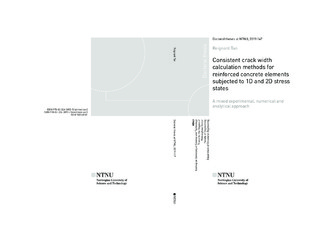| dc.contributor.advisor | Kanstad, Terje | |
| dc.contributor.advisor | Hendriks, Maximiliaan A. | |
| dc.contributor.advisor | Geiker, Mette Rica | |
| dc.contributor.advisor | Brekke, Dan-Evert | |
| dc.contributor.author | Tan, Reignard | |
| dc.date.accessioned | 2019-08-02T11:52:27Z | |
| dc.date.available | 2019-08-02T11:52:27Z | |
| dc.date.issued | 2019 | |
| dc.identifier.isbn | 978-82-326-3893-2 | |
| dc.identifier.issn | 1503-8181 | |
| dc.identifier.uri | http://hdl.handle.net/11250/2607051 | |
| dc.description.abstract | Predicting crack widths in reinforced concrete (RC) structures is important for Serviceability Limit State (SLS) design. Crack widths exceeding the requirements can impair the functionality of a structure, limit its use and even reduce the service life. Calculation methods for predicting crack widths in one-way bearing structural elements have been developed for several decades and are relatively straightforward in use for design of conventional RC ties, beams and slabs. This is not the case for more complicated structural elements with large reinforcing bars (rebars) and covers, such as shear walls, two-way bearing slabs and shells typically occurring in large-scale concrete structures. Complete guidelines for predicting crack widths in such cases do not exist, and the influence of large rebars and covers on the cracking behaviour of RC structures is still not clear. Large-scale concrete structures are among others intended to be used for the planned coastal highway route “Ferry-free E39” in Norway.
The main objective in this thesis was formulated to facilitate a calculation model capable of predicting crack widths in large-scale concrete structures consistently. The study is subdivided into two parts as i) evaluation and ii) improvement of the current practice.
The evaluation reveals that the semi-empirical formulas recommended by Eurocode 2 (EC2) and fib Model Code 2010 (MC2010) yield inconsistent crack width predictions, particularly in cases of large rebars and covers. EC2 prove to yield overly conservative crack width predictions, in average predicting twice the size of maximum crack widths measured from an experimental study of RC ties. This could have severe economic consequences in a typical design situation.
An improved crack width calculation model was formulated by using the basic principles in solid mechanics, which lead to deriving and solving the second order differential equation for the slip using the bond-slip law recommended by MC2010, however, with adjusted parameters to account for the behaviour of RC ties. This resulted in the Modified Tension Chord Model (MTCM), essentially replacing the Tension Chord Model (TCM) in the Cracked Membrane Model (CMM), to formulate the Modified Cracked Membrane Model (MCMM) that is capable of predicting crack widths in large-scale concrete structures.
Comparison with crack widths measured from experiments reported in the literature showed that the MCMM predicted crack widths consistently and with a mean for the modelling uncertainty for crack width predictions being fairly close to one but still on the conservative side regardless of rebar and cover size. A simplified approach was formulated as an alternative method to the MCMM, in addition to a generalized expression for predicting tension stiffening normal to a crack, a feature currently missing in EC2 and MC2010. The simplified approach was consistent in its predictions but more conservative than the MCMM, as expected. The results in the thesis suggest that both the MCMM and the simplified approach show great potential for yielding consistent crack width predictions of large-scale concrete structures, and in general better predictions than offered by EC2 and MC2010 for SLS design. Finally, the thesis offers complete guidelines for predicting crack widths in large-scale concrete structures subjected to in-plane loading. | nb_NO |
| dc.language.iso | eng | nb_NO |
| dc.publisher | NTNU | nb_NO |
| dc.relation.ispartofseries | Doctoral theses at NTNU;2019:147 | |
| dc.relation.haspart | Paper 1: Tan, Jesus Reignard Medel; Eileraas, Kristoffer B.; Opkvitne, Ola; Zirgulis, Giedrius; Hendriks, Max; Geiker, Mette Rica; Brekke, Dan-Evert; Kanstad, Terje. Experimental and theoretical investigation of crack width calculation methods for RC ties. Structural Concrete 2018 ;Volum 19.(5) s. 1436-1447 | nb_NO |
| dc.relation.haspart | Paper 2: Tan, Jesus Reignard Medel; Hendriks, Max; Geiker, Mette Rica; Kanstad, Terje. A numerical investigation of the cracking behaviour of reinforced-concrete tie elements. Magazine of Concrete Research 2019 | nb_NO |
| dc.relation.haspart | Paper 3:
Tan, Reignard:; Hendriks, Max; Geiker, Mette; Kanstad, Terje.
Analytical calculation model for predicting the craking behavior of reinforced concrete ties.
- This material may be downloaded for personal use only. Any other use requires prior permission of the American Society of Civil Engineers. | nb_NO |
| dc.relation.haspart | Paper 4: Tan, Jesus Reignard Medel; Hendriks, Max; Geiker, Mette Rica; Kanstad, Terje. Modified cracked membrane model for consistent crack width predictions of reinforced concrete structures subjected to in-plane loading. Engineering structures 2019 ;Volum 196.
https://doi.org/10.1016/j.engstruct.2019.109362 | nb_NO |
| dc.relation.haspart | Paper 5:
Tan, Jesus Reignard Medel; Hendriks, Max; Kanstad, Terje.
An investigation of the strain profile over the cover in reinforced concrete elements subjected to tension. fib Congress 2018 | |
| dc.subject | Crack widths, crack spacing, tension stiffening, calculations, large-scale concrete structures, membrane elements | nb_NO |
| dc.title | Consistent crack width calculation methods for reinforced concrete elements subjected to 1D and 2D stress states A mixed experimental, numerical and analytical approach | nb_NO |
| dc.type | Doctoral thesis | nb_NO |
| dc.subject.nsi | VDP::Technology: 500::Building technology: 530::Construction technology: 533 | nb_NO |
